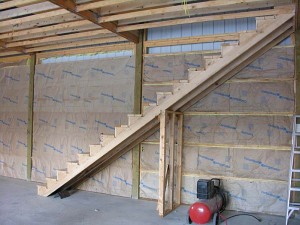It Takes a Hole to Raise a Stair
Or at least a hole adequate to get the stairs through to the floor above!
to get the stairs through to the floor above!
I’m a big guy – 6’5” in my bare feet. When stairs have inadequate headroom, my forehead pays the price. When it comes to calculating adequate headroom, most people display their skills of being dimensionally challenged.
The 2012 IBC (International Building Code) is fairly specific when it comes to stairs, and provides a wealth of information:
1009.4 Width.
The width of stairways shall be determined as specified in Section 1005.1, but such width shall not be less than 44 inches (1118 mm).
Exceptions:
Stairways serving an occupant load of less than 50 shall have a width of not less than 36 inches (914 mm).
1009.5 Headroom.
Stairways shall have a minimum headroom clearance of 80 inches (2032 mm) measured vertically from a line connecting the edge of the nosings. Such headroom shall be continuous above the stairway to the point where the line intersects the landing below, one tread depth beyond the bottom riser. The minimum clearance shall be maintained the full width of the stairway and landing.
Exceptions:
- In Group R-3 occupancies; withindwelling unitsin Group R-2 occupancies; and in Group U occupancies that are accessory to a Group R-3 occupancy or accessory to individual dwelling units in Group R-2 occupancies; where the nosings of treads at the side of a flight extend under the edge of a floor opening through which the stair passes, the floor opening shall be allowed to project horizontally into the required headroom a maximum of 43/4 inches (121 mm).
1009.7.2 Riser height and tread depth.
Stair riser heights shall be 7 inches (178 mm) maximum and 4 inches (102 mm) minimum. The riser height shall be measured vertically between the nosings of adjacent treads. Rectangular tread depths shall be 11 inches (279 mm) minimum measured horizontally between the vertical planes of the foremost projection of adjacent treads and at a right angle to the tread’s nosing. Winder treads shall have a minimum tread depth of 11 inches (279 mm) between the vertical planes of the foremost projection of adjacent treads at the intersections with the walk line and a minimum tread depth of 10 inches (254 mm) within the clear width of the stair.
Exceptions:
- In Group R-3 occupancies; within dwelling units in Group R-2 occupancies; and in Group U occupancies that are accessory to a Group R-3 occupancy or accessory to individual dwelling units in Group R-2 occupancies; the maximum riser height shall be 73/4inches (197 mm); the minimum tread depth shall be 10 inches (254 mm).
In general, if one plans around a run of 11 inches and a rise of seven inches, this will get them off to a ‘safe’ start.
To get 80 inches of minimum headroom above the stairs, the thickness of the floor being passed through also has to be accounted for (the floor joists and subfloor sheathing).
With 2×8 joists and ¾” thick sheathing, 88 inches is the magic number. Dividing by the seven inches of maximum rise, it will have 13 risers, which includes the floor at the top. The 12 remaining stairs must travel 132 inches, or 11 feet (this would also hold true for 2×10 joists).
When floor joists go to 2×12, then the length of the hole must be increased to 11’11”. If a beam larger than 17-1/4 inches thick must be passed beneath at the ‘going down’ end of the stair hole, then the hole will need to be longer yet.
A safe rule of thumb for the great majority of cases– allow for a stair hole the width of the stairs plus one inch and a length of 12 feet.






